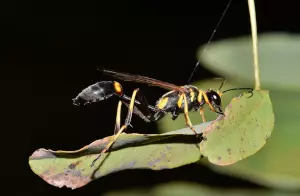Learn about Mud Dauber Wasps in Utah

Mud Dauber Wasps
Mud dauber is a common name for a wasp that constructs its nest of mud. There are many species of wasps referred to as mud daubers, such as Organ Pipe mud daubers, black-and-yellow mud daubers and blue mud daubers. Mud daubers are commonly found throughout the United States.
The female wasp constructs hollow clay units one at a time, each the dimensions of a pitted date. The mother mud dauber gathers the wet clay in pellets. At the nest site, she draws the pellet into a ribbon of clay which becomes the next arch of the tubular nest. While working the clay, she audibly buzzes her flight muscles. This vibration visibly liquefies the clay for a few seconds. This strengthens its bond of the clay.
An inside look at the mud daubers nest.
These nests can be commonly found around your home or property. Unlike the wasps and hornets that you are used to seeing, mud dauber wasps do not live in colonies or defend their nests. They are also not aggressive, but will defend themselves if they feel threatened. They are often found in warmer months and can be found across Mexico, United States, and Canada.
Mud daubers are known for their trademark nests, which look like pipes and contain several chambers (each housing a single egg). Mud dauber nests differ from other wasp nests because there are no combs. The organ-pipe mud dauber constructs nests that look like long, thin pipes, while other mud daubers typically create urn-shaped nests.
How do they build their nests?
The female dauber locates an area with an abundant supply of mud (clay is her favorite). The mud dauber will collect mud from several sites, so you may notice nests with several different colors of mud. She then constructs the nest by herself while the male dauber guards it.
She uses her mandible (jaw) to roll up soft mud into a ball. She carries this ball with her front legs to the location she has selected for construction. With her head and mandible, she presses the mud onto a flat surface and uses her saliva to shape it into an urn or tube-like structure.
How do they use the nest?
Once finished, the female hunts down spiders and places a spider into each chamber. She then lays one egg each on top of the spider and abandons the nest. When the eggs hatch, each larvae feeds on its own spider and eats its way through the nest’s walls when it emerges in adulthood.
How do they hunt the spiders?
The mother wasp collects spiders, often plucking them straight from their webs after a pitched battle. She permanently paralyzes each spider using her venomous sting. The venom is not lethal. Rather, it is paralytic, keeping the spider alive and fresh but helplessly immobile, a gruesome spider buffet for her grub-like larva to eat. Each hollow nest is packed with a half dozen spiders, one of which receives her egg. In a few weeks time, the growing wasp larva finishes eating its buffet and pupates, becoming dormant for the winter.
Organ Pipe Mud Dauber with a spider.
Should I be worried if I see them?
The short answer is no, they are not aggressive towards humans and are actually looked upon as a natural pest control. They eat all kinds of household bugs or pests that may be around your home and also capture spiders as mentioned above to feed their young. However, if they are causing you or your family problems do not hesitate to call Beeline Pest Control.
For more information about mud daubers in Utah you can read here and here.

